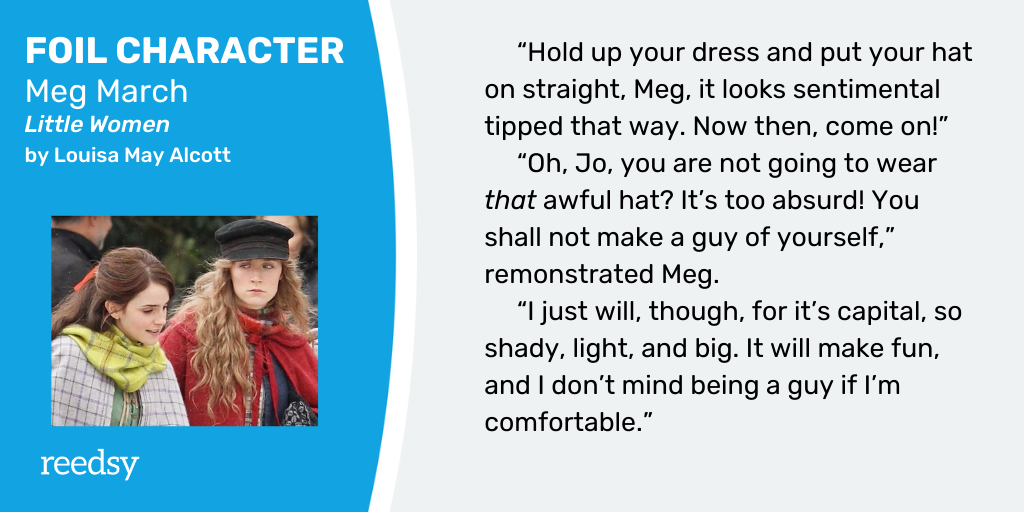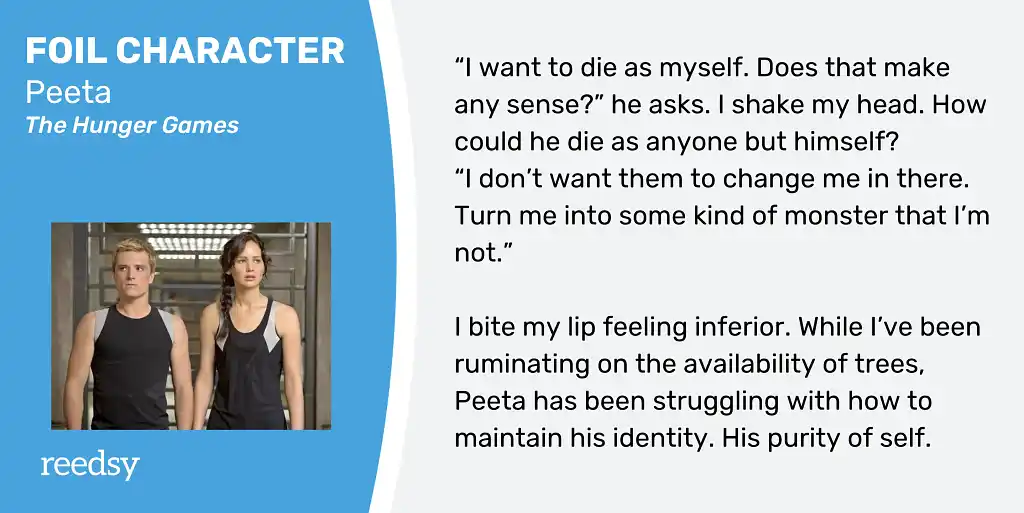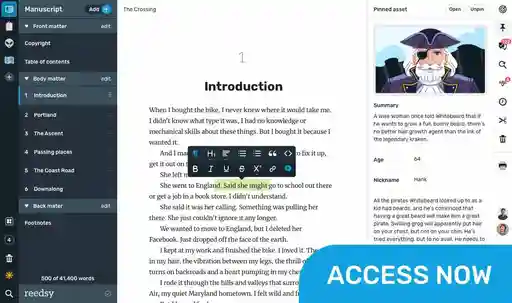Last updated on Oct 15, 2025
What is a Foil Character? Definition, Purpose, and Examples
Martin Cavannagh
Head of Content at Reedsy, Martin has spent over eight years helping writers turn their ambitions into reality. As a voice in the indie publishing space, he has written for a number of outlets and spoken at conferences, including the 2024 Writers Summit at the London Book Fair.
View profile →A foil character is one whose traits sharply contrast with another’s — most often the protagonist’s — to draw attention to that character’s defining strengths, flaws, or values. The term comes from a jeweler’s technique of placing metallic foil behind a gem to make it sparkle. Shakespeare famously references the concept in Henry IV, Part 1:
And like bright metal on a sullen ground/ My reformation, glittering o'er my fault/ Shall show more goodly and attract more eyes/ Than that which hath no foil to set it off.
Think of Laertes’ decisive nature against Hamlet’s hesitation, Hotspur’s fiery temperament beside Prince Hal’s cool calculation, or Jane Bennet’s gentleness set against Elizabeth’s biting wit. A character can tell you who they are, but put them beside someone wildly different and suddenly their true nature shines brighter.
In this post, we’ll explore a range of classic and modern character examples that show how to use foil characters in writing. And because no foil worth their salt exists without a reason, let’s delve into exactly what this literary sidekick (or sparring partner) does, how they do it, and why it matters!
Foil characters spotlight the protagonist’s qualities
Again, the foil character’s primary duty is to contrast with the main character. Think of it this way: when you’ve spent all summer pedaling an old rusty bike, you’re really going to feel the difference when you get a new bike in September!
Sure, anyone can see that the new bike is nicer… but only you can feel how smooth the gears are, how light the frame is, and how sensitive the brakes are in your hands. That’s the power of contrast — and that’s how foil characters work in a story, too.
That said, you don’t want to be too transparent with your foil characters. The essence of this technique lies in showing the protagonist’s qualities indirectly! When used well, a foil character subtly reveals aspects of the protagonist that might have stayed hidden otherwise — clarifying their true nature and leaving a greater impression on the reader. Here are some common contrasts in different kinds of characters:
-
Emotional impulsivity vs. gritty pragmatism (Theo vs Boris in The Goldfinch)
-
Free-spirited spontaneity vs. strict creative discipline (Daisy Jones vs. Billy Dunne in Daisy Jones & The Six)
-
Shrewd and mistrustful vs. impulsive and trusting (Kaz Brekker vs. Jesper Fahey in Six of Crows)
-
Tyrannical vs. liberal (Napoleon vs. Snowball in Animal Farm)
-
Intuitive vs. logical (Kirk vs. Spock in Star Trek)
Foil character example #1: John Watson and Sherlock Holmes

Holmes and Watson work together to solve the same crimes, but operate very differently: Watson is pragmatic and modest, accentuating Holmes’ eccentricities and confidence — while his own unusual methods contrast with Watson’s more conventional, by-the-book approach.
Yet this juxtaposition also elevates Watson in a way, showing that his intelligence is nothing to scoff at. The fact that he is consistently impressed by Holmes’ eccentric solutions only makes Holmes look more brilliant. In this way, Watson is a great stand-in for the reader; he’s perfectly smart and competent, yet still can’t predict what Holmes will do next — which makes us feel better that we can’t, either!
Free course: Character Development
Create fascinating characters that your readers will love... or love to hate! Get started now.
They can serve as compelling antagonists
“Curses! Foiled again!” sounds like the catchphrase of a cartoon villain — which may be one reason why some readers assume that foils are always “the bad guys.”
In truth, a foil can be an ally, a friendly rival, or, yes, an outright antagonist. But in cases where the protagonist’s foil is their enemy, it does often lead to richer, higher-stakes conflict. There’s nothing like a clash in values or perspectives to give your protagonist and antagonist something big to fight about!
This conflict can be especially intriguing when the hero and villain come from similar backgrounds — yet still wind up with completely opposing worldviews. As Christopher Booker notes in The Seven Basic Plots: Why We Tell Stories (2004):
The hero may have a subtler type of alter-ego whose role is to serve as a foil, displaying qualities the opposite of those shown by the hero.
To quote another villainous cliché, you will often hear James Bond’s enemies say: “We’re not so different, you and I.” Indeed, when the antagonist is an “alter-ego” of sorts for the protagonist, their differences end up being even more striking. By pitting these characters against each other, a writer can emphasize their contrasting qualities and make the narrative more interesting.
Foil character example #2: Draco Malfoy and Harry Potter

Hogwarts classmates Harry and Malfoy are, in some ways, remarkably similar. They’re both smart, ambitious leaders (Harry was almost sorted into Slytherin for this very reason!) with clear goals. They’re also both regarded as “high status” figures at school — Harry because of his celebrity status, Malfoy as the scion of a wealthy clan.
These similarities make them inclined to occupy similar positions and roles at Hogwarts, which naturally leads to conflict. It’s within these conflicts that their differences become evident. For example, in the passage above, it’s quickly made clear that Malfoy holds classist and generally prejudiced views — and that Harry is disgusted by this attitude.
And this is only the beginning of their longstanding relationship as foils. Over the course of the series, Malfoy continues to use his wealth and status to belittle and control others, while Harry continues to exercise compassion even in his darkest moments. As a result, compared to Malfoy’s selfish and conniving nature, Harry’s kindness shines even brighter.
A foil character might contextualize an unusual protagonist
Another way to use foil characters in writing is as providers of cultural context. That is, when a story takes place outside a reader’s own culture or community, the best way to show what’s “outside the norm” is by contrasting a conformist with a rebel!
In this way, foil characters can demonstrate just how unusual the protagonist’s mindset is for their era, culture, or even their genre. Needless to say, this won’t apply to all stories — but it can be handy to use foils this way when writing something like a period piece, or science fiction that takes place in a totally different world.
Foil character example #3: Meg and Jo March in Little Women

Though not “historical” when it was first published, Little Women has since become a poignant snapshot of mid-19th century life. The book remains beloved for its tender prose and vivid characters, and does a particularly good job of presenting Jo’s sisters as foils to her own character — each in a slightly different way.
The strongest contrast exists between Meg, who is conventional and feminine, and Jo, who is tomboyish, impulsive, and defiant. Meg is Jo’s greatest foil not just because they act differently from one another, but because they have almost polar-opposite values and goals. Meg values tradition and stability, balanced by the occasional frilly indulgence. Jo cares for none of these things — she wants to write, become famous, and (perhaps most importantly) to never settle down with a man.
As the book progresses and we see Meg marry and have children, we understand just how different she is from Jo. Then, when we watch Jo unapologetically pursue her writing dreams and even reject a proposal from her best friend Laurie, her unusual (for the time) priorities and methods stand out even more. Through the foil character of Meg, Alcott shows Jo to be truly unique.
They symbolize the hero’s internal conflicts
Of course, sometimes the conflict that appears in conjunction with a foil character isn’t really external, but instead represents an internal conflict the main character is having.
Imagine a princess who is bound by royal responsibilities and obligations, yet has had a strong desire for independence her whole life. Then imagine the princess’s foil: her mother, the long-serving queen who tries to convince her daughter to take her duties more seriously.
In this case, yes, the queen is a person with her own principles and opinions — but she may also represent the more “traditional” side of her daughter. In arguing with her mother, the princess feels increasingly conflicted: should she steal away one night and be free? Or remain loyal and devoted to her kingdom as its future ruler?
Basically, the purpose of a foil character like our queen is to bring a protagonist’s internal conflict to the surface. And when things come to a head, that inner struggle can dovetail nicely with some external trouble — creating a more layered, satisfying narrative.
Foil character example #4: Peeta and Katniss in The Hunger Games
 In The Hunger Games, Katniss is fiercely independent, guarded, and often distrustful of others — traits borne from years of surviving extremely harsh conditions in District 12. By contrast, Peeta is open-hearted, diplomatic, and deeply committed to cooperation, even in the face of danger. This is also another great example of foil characters who come from the same origins, yet have very different outlooks.
In The Hunger Games, Katniss is fiercely independent, guarded, and often distrustful of others — traits borne from years of surviving extremely harsh conditions in District 12. By contrast, Peeta is open-hearted, diplomatic, and deeply committed to cooperation, even in the face of danger. This is also another great example of foil characters who come from the same origins, yet have very different outlooks.
As a foil, Peeta illuminates Katniss’s defining qualities: her instincts to take charge, stay strong, and never rely on anyone. Peeta’s selflessness and ability to connect with others push Katniss to confront her own emotional barriers. Their differences generate internal conflict for Katniss (does she let herself be vulnerable, or keep resisting?), as well as external conflict when they disagree — both during the Games and out of them.
By contrasting Katniss with someone who embodies kindness and trust, Suzanne Collins expertly shows just how difficult it is for her to open up (or hope!) — and how essential Peeta is in her journey to become the Mockingjay.
They set the stage for the protagonist’s reactions
Lastly, remember that a foil doesn’t have to be a “character”, per se. Things like settings and even objects can be foils for your protagonist too!
If you’ve ever felt like you didn’t fit in with your surroundings, perhaps you understand how this works: that sense of being a fish out of water. Think of rom-coms where the big city girl is suddenly thrust into a country setting, or SFF novels where an ordinary “chosen one” is forced to contend with a complex fantastical world.
In literature, this is often called a symbolic foil: when a setting, object, or environment contrasts with the protagonist in order to highlight their key qualities. And a protagonist who feels “wrong” in a particular setting not only sticks out like a sore thumb, but may even be in some kind of danger. If the clash is strong enough, this kind of setting-as-foil can even direct the story’s outcome.
Example of setting as a foil: The countryside in Madame Bovary
In Gustave Flaubert’s Madame Bovary, Emma Bovary yearns for a more exciting and luxurious life than the French countryside can offer her. Her desires for wealth and beauty contrast sharply with the realities of her provincial life.
This friction between Emma and her rural setting essentially drives the novel forward — with Emma gathering huge debts as she lives far beyond her means, eventually leading to her suicide. Indeed, this is perhaps our most dramatic example of a literary foil — and shows how even when a foil is “static” (that is, the countryside itself does not plot Emma’s downfall), it can still exert huge narrative influence.
More examples of foil characters
|
Work / Author |
Protagonist |
Foil |
Highlighted Traits |
Narrative Function |
|
Strange Case of Dr Jekyll & Mr Hyde (Stevenson) |
Dr. Jekyll |
Mr. Hyde |
Morality vs. immorality |
Illustrates the duality of human nature and the struggle between good and evil. |
|
Romeo and Juliet (Shakespeare) |
Romeo |
Mercutio |
Romantic vs. cynical |
Contrasts idealistic love with a skeptical view of romance, intensifying Romeo’s passion. |
|
Pride and Prejudice (Austen) |
Elizabeth Bennet |
Caroline Bingley |
Integrity vs. vanity |
Highlights Elizabeth’s sincerity and moral strength by contrasting it with Caroline’s superficiality. |
|
Frankenstein (Shelley) |
Victor Frankenstein |
The Creature |
Ambition vs. empathy |
Shows the consequences of unchecked ambition compared to the need for compassion. |
|
To Kill a Mockingbird (Lee) |
Atticus Finch |
Bob Ewell |
Justice vs. prejudice |
Emphasizes Atticus’s moral clarity by opposing him to Ewell’s bigotry. |
|
The Lord of the Rings (Tolkien) |
Gandalf |
Saruman |
Wisdom vs. corruption |
Demonstrates the moral dangers of power by showing how similar beginnings can lead to opposite ends. |
|
Of Mice and Men (Steinbeck) |
George |
Lennie |
Sharpness vs. innocence |
Highlights the tension between realism and idealism in human relationships. |
|
The Great Gatsby (Fitzgerald) |
Jay Gatsby |
Tom Buchanan |
Idealism vs. cynicism |
Highlights the moral and social decay beneath wealth and glamour. |
|
Hamlet (Shakespeare) |
Hamlet |
Laertes |
Contemplation vs. impulsiveness |
Contrasts two approaches to revenge, deepening the play’s moral complexity. |
|
Les Misérables (Hugo) |
Jean Valjean |
Javert |
Mercy vs. rigid justice |
Explores the conflict between redemption and inflexible law. |
|
1984 (Orwell) |
Winston Smith |
O'Brien |
Rebellion vs. authoritarianism |
Intensifies the tragedy by contrasting Winston’s hope with O’Brien’s loyalty to oppression. |
|
Macbeth (Shakespeare) |
Macbeth |
Banquo |
Ambition vs. honour |
Highlights the corrupting influence of unchecked ambition through Banquo’s restraint. |
Readers don’t just learn who a character is by what they say or do — they learn by comparing them to someone else. A foil character holds a mirror (sometimes a pretty unflattering one!) up to the protagonist so readers can do exactly that. It’s not just clever writing; strong foil characterization can carry an entire story when done right.
Interested in other ways to add intrigue to your characters? Check out our posts on creating better characters, our profile creation sheet, and our one-of-a-kind character interview.








